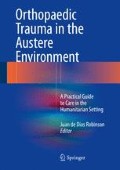Abstract
The main influence a trauma surgeon has on fracture healing is soft-tissue care and stabilization of the fracture. Treatment of long-bone diaphyseal and many metaphyseal fractures is best accomplished by intramedullary (IM) nail interlocking screw systems. In settings where resources are in abundance, interlocking screws are typically placed using C-arm imaging, fracture tables, and other specialized equipment. These are not available in many developing countries, and therefore creativity is necessary to accomplish equivalent results. This chapter will describe innovations to accomplish placement of the IM nail and interlocking screws without these technological aids. The chapter is divided into sections for femur, tibia, humerus, hip, and pediatric femoral fractures.
Access this chapter
Tax calculation will be finalised at checkout
Purchases are for personal use only
References
SIGN Surgical Database. SIGN Fracture Care International. 2014. Accessed 2/14/2014.
Shah RK, Moehring HD, Singh RP, Dhakal A. Surgical Implant Generation Network (SIGN) intramedullary nailing of open fractures of the tibia. Int Orthop. 2004;28:163–6.
Ikem IC, Ogunlusi JD, Ine HR. Achieving interlocking nails without using an image intensifier. Int Orthop. 2007;31:487–90.
Ikpeme I, Ngim N, Udosen A, Onuba O, Enembe O, Bello S. External jig-aided intramedullary interlocking nailing of diaphyseal fractures: experience from a tropical developing centre. Int Orthop. 2011;35:107–11.
Naeem-Ur-Razaq M, Qasim M, Khan MA, Sahibzada AS, Sultan S. Management outcome of closed femoral shaft fractures by open Surgical Implant Generation Network (SIGN) interlocking nails. J Ayub Med Coll Abbottabad. 2009;21:21–4.
Ogunlusi JD, St Rose RS, Davids T. Interlocking nailing without imaging: the challenges of locating distal slots and how to overcome them in SIGN intramedullary nailing. Int Orthop. 2010;34:891–5.
Shearer D, Cunningham B, Zirkle L. Population characteristics and clinical outcomes from the SIGN online surgical database. Tech Orthop. 2009;24:273–6.
Young S, Lie SA, Hallan G, Zirkle LG, Engesaeter LB, Havelin LI. Low infection rates after 34,361 intramedullary nail operations in 55 low- and middle-income countries: validation of the Surgical Implant Generation Network (SIGN) online surgical database. Acta Orthop. 2011;82:737–43.
Young S, Lie SA, Hallan G, Zirkle LG, Engesaeter LB, Havelin LI. Risk factors for infection after 46,113 intramedullary nail operations in low- and middle-income countries. World J Surg. 2013;37:349–55.
Gosselin RA, Heitto M, Zirkle L. Cost-effectiveness of replacing skeletal traction by interlocked intramedullary nailing for femoral shaft fractures in a provincial trauma hospital in Cambodia. Int Orthop. 2009;33:1445–8.
Gosselin R, Lavaly D. Perkins traction for adult femoral shaft fractures: a report on 53 patients in Sierra Leone. Int Orthop. 2007;31:697–702.
Blasier RD, Aronson J, Tursky EA. External fixation of pediatric femur fractures. J Pediatr Orthop. 1997;17:342–6.
Domb BG, Sponseller PD, Ain M, Miller NH. Comparison of dynamic versus static external fixation for pediatric femur fractures. J Pediatr Orthop. 2002;22:428–30.
Skaggs DL, Leet AI, Money MD, Shaw BA, Hale JM, Tolo VT. Secondary fractures associated with external fixation in pediatric femur fractures. J Pediatr Orthop. 1999;19:582–6.
Nowotarski PJ, Turen CH, Brumback RJ, Scarboro JM. Conversion of external fixation to intramedullary nailing for fractures of the shaft of the femur in multiply injured patients. J Bone Joint Surg Am. 2000;82:781–8.
Bedi A, Karunakar MA. Physiologic effects of intramedullary reaming. Instr Course Lect. 2006;55:359–66.
Giannoudis PV, Snowden S, Matthews SJ, Smye SW, Smith RM. Temperature rise during reamed tibial nailing. Clin Orthop Relat Res. 2002:(395)255–61. PubMed PMID: 11937890.
Henry SL, Adcock RA, Von Fraunhofer JA, Seligson D. Heat of intramedullary reaming. South Med J. 1987;80:173–6.
Leunig M, Hertel R. Thermal necrosis after tibial reaming for intramedullary nail fixation. A report of three cases. J Bone Joint Surg Br. 1996;78:584–7.
Roberts JW, Libet LA, Wolinsky PR. Who is in danger? Impingement and penetration of the anterior cortex of the distal femur during intramedullary nailing of proximal femur fractures: preoperatively measurable risk factors. J Trauma Acute Care Surg. 2012;73:249–54.
Horn J, Schlegel U, Krettek C, Ito K. Infection resistance of unreamed solid, hollow slotted and cannulated intramedullary nails: an in-vivo experimental comparison. J Orthop Res. 2005;23:810–5.
Patton GC, Coffey C, Sawyer SM, Viner RM, Haller DM, Bose K, Vos T, Ferguson J, Mathers CD. Global patterns of mortality in young people: a systematic analysis of population health data. Lancet. 2009;374:881–92.
Roth J, Shearer D, Zirkle LGJ, Johnson A, LaBarre P. Development and biomechanical testing of the SIGN hip construct. Tech Orthop. 2009;24:265–72. 210.1097/BTO.1090b1013e3181c1093ef1047.
Author information
Authors and Affiliations
Corresponding author
Editor information
Editors and Affiliations
Rights and permissions
Copyright information
© 2016 Springer International Publishing Switzerland
About this chapter
Cite this chapter
Shearer, D., Zirkle, L. (2016). Experience Using the IM Interlocking Screw System in Austere Environment. In: Robinson, J. (eds) Orthopaedic Trauma in the Austere Environment. Springer, Cham. https://doi.org/10.1007/978-3-319-29122-2_31
Download citation
DOI: https://doi.org/10.1007/978-3-319-29122-2_31
Published:
Publisher Name: Springer, Cham
Print ISBN: 978-3-319-29120-8
Online ISBN: 978-3-319-29122-2
eBook Packages: MedicineMedicine (R0)

